General advice warning:
The information and any advice provided in this booklet has been preparedwithouttaking into account your objectives, financialsituation or needs. Because ofthat, you should, before acting on the advice, considerthe appropriateness ofthe advice, having regard to those things.
Retirement Toolkit
Retirement in Australia is evolving. With Australians living longer than ever, today’s retirees face a dynamic mix of opportunities and challenges. They need financial security amid rising living costs, access to quality health care, a safe and comfortable home, and ways to stay socially connected and purposeful. This tool kit is designed to help Australian retirees(and those nearing retirement) navigate these key areas, providing guidance and practical tips to enhance their retirement years. From managing money matters to embracing a fulfilling lifestyle, each section of the toolkit addresses a core need – helping you transition into or enrich your retirement with confidence and peace of mind.
SOCIAL LIFE & PURPOSE
Retirement is often imagined as a leisure paradise, but one challenge can be the loss of routine and social connections that working life provided. Many new retirees find themselves asking, “What will I do all day, and with whom?” Humans are social creatures, and staying connected is crucial for mental and emotional well-being. Having a sense of purpose – whether it’s volunteering, a hobby, caring for family, or even a part-time job – is equally important. Studies consistently show that retirees with active social lives and meaningful activities tend to be happier and even healthier. On the flip side, social isolation can be a serious issue. A recent survey in NSW found that three in five older adults reported feeling lonely and half felt socially isolated – a stark reminder that we need to actively nurture our social networks as we age.
The good news is that retirement can offer more time to connect with friends, family, and community in ways you couldn’t while working full-time. You can rekindle old friendships, join clubs, travel with peers, or engage in your community without the constraints of a 9-to-5 job. Many retirees say they are busier than ever – but now it’s with things they enjoy. Whether it’s joining the local Men’s Shed (a great Aussie initiative for men’s social interaction and projects), the Country Women’s Association, a bowling club, book club, or the local church or cultural group, there are plenty of avenues to meet people. Below are steps to enhance your social life and sense of purpose, followed by practical tips.
Financial Planning & Security
The table below summarizes these figures:
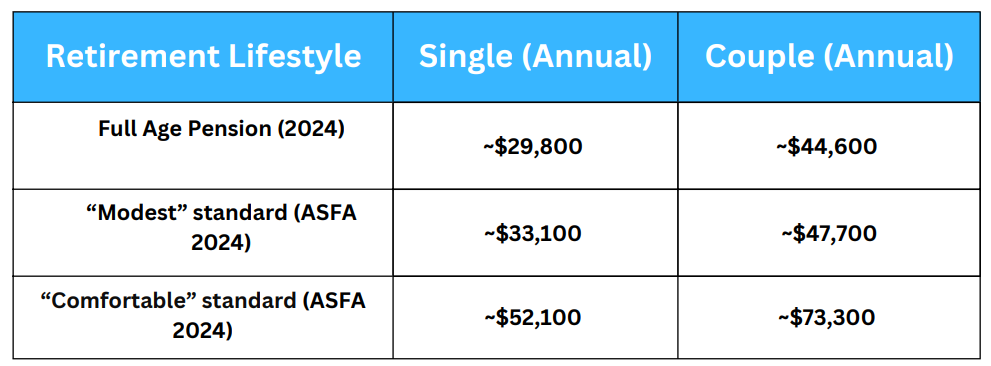
(All figures assume retirees own their home outright.)
Understanding these benchmarks can help you evaluate your own situation. If there’s a gap between your expected expenses and your expected income, don’t panic – there are steps you can take (and government supports to tap into) to close it. The key is to have a plan rather than “winging it,” because retirees who plan financially tend to feel more confident and happier in retirement. Below, we outline some key steps and top tips for financial security
Key Steps
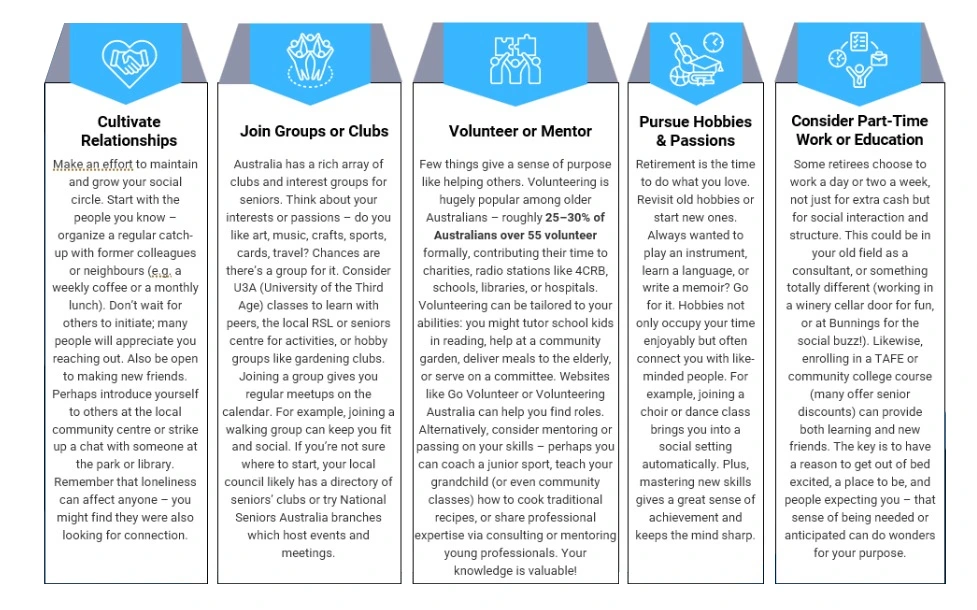
Top 5 Tips
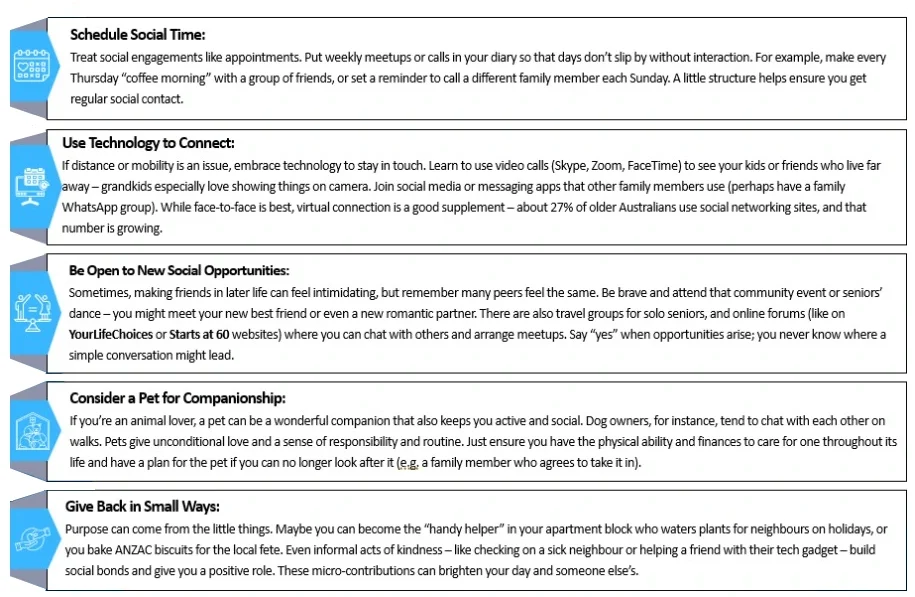
SOCIAL LIFE & PURPOSE
Building a satisfying social life in retirement may take a bit of initiative, but it pays huge dividends in happiness. If you ever feel persistently lonely, know that there are resources to help: organizations like FriendLine offer telephone chat services for seniors feeling isolated, and the government’s strategy on loneliness is growing after recognition that it’s a public health issue. You are not alone – literally millions of retirees are seeking connection and meaning just like you. By putting yourself out there and staying engaged, you’ll likely find your tribe and thrive in this new chapter of life.
HAPPINESS & LIFESTYLE MINDSET
Retirement is as much a psychological journey as it is a financial or physical one. Shifting from a structured work life to the freedom of retirement can be liberating – but it can also leave some feeling adrift. That’s why cultivating a positive retirement mindset and focusing on what truly brings you happiness is crucial. In your working years, your sense of purpose and identity might have revolved around your career or raising a family. In retirement, you get to redefine that identity on your own terms. This is both exciting and a little daunting. The key is to embrace a growth mindset – seeing retirement not as “the end” but as a new phase ripe with opportunities to learn, grow, and find joy in different ways.
Interestingly, research shows that many Australians are quite happy in retirement. A 2025 survey (the Challenger Retirement Happiness Index) found that those already retired reported a higher happiness score (average 70/100) compared to those still in the workforce approaching retirement (66/100). Free from work stress and with time to pursue personal interests, many retirees flourish. The same research highlighted what drives retiree happiness: staying active with enjoyable activities, maintaining good mental and physical health, and having a sense of purpose were top factors. Financial security matters too (around 41% said having enough money to enjoy life is a key to happiness), but money alone isn’t everything – meaningful engagement in life and relationships rank higher. This suggests that a happy retirement is one where you keep growing, connecting, and contributing in some way.
So how can you cultivate a mindset for a fulfilling retirement? Think about your attitudes and habits: are they aligned with the life you want now? It might involve letting go of certain work-related pressures (like the need to always be “productive” in a conventional sense) and instead valuing experiences, learning, and leisure for their own sake. It also means being gentle with yourself as you adjust – it’s normal to have ups and downs. Here are some steps and tips to help nurture happiness and a positive lifestyle mindset as you navigate retirement.
Key Steps
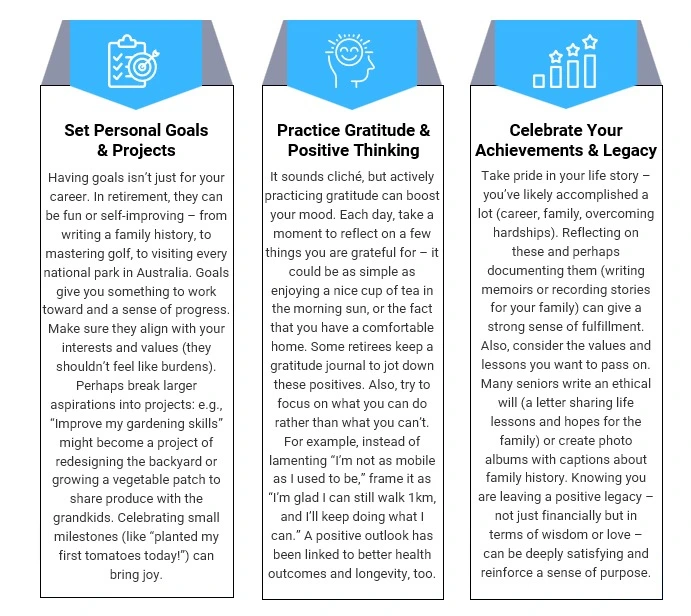
Key Steps
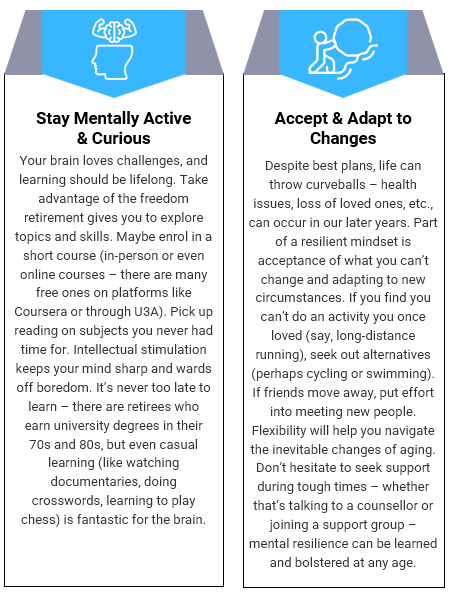
Top 5 Tips
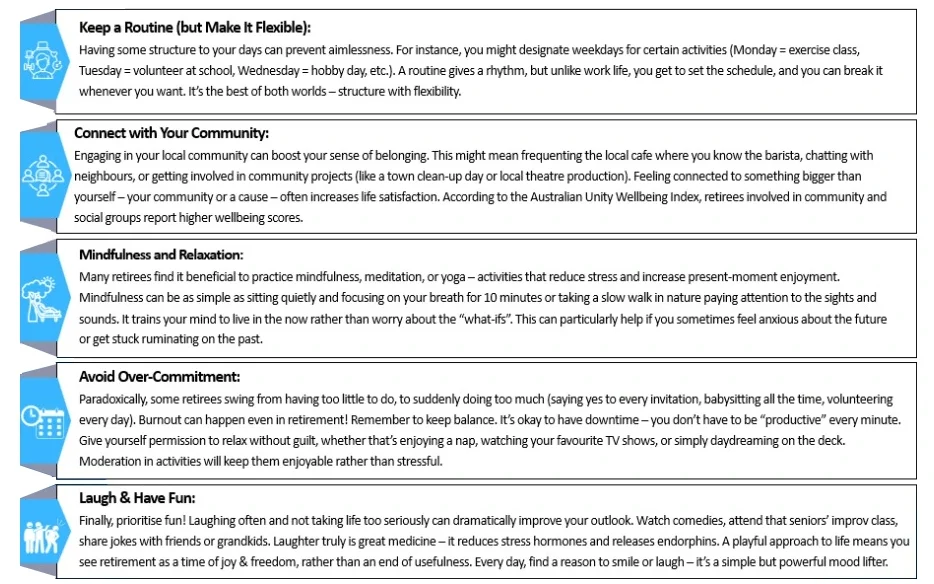
HAPPINESS & LIFESTYLE MINDSET
Developing a fulfilling retirement lifestyle is an ongoing process. There’s no “right” way to do it – some people thrive on travel and adventure, others find contentment in quiet routines and family time. Know thyself, and craft a life that suits you. If you occasionally feel a lack of direction, remember it’s normal; just revisit your interests and values, maybe try something new to spark excitement. As one retiree said, “Retirement is not a destination, it’s a journey – and I’m learning and evolving all the time.” With a positive mindset and openness to change, this journey can be one of the happiest phases of your life.
TECHNOLOGY & SAFETY
In today’s world, technology is a gateway to convenience, connection, and information – and it doesn’t have to be intimidating. Many Australian seniors are tech-savvy, using smartphones, tablets, and the internet daily. Even if you’re not naturally inclined toward gadgets, learning some tech basics can greatly enhance your retirement lifestyle. From staying in touch with family on video calls, to managing your banking online, to streaming your favourite shows – tech can enrich your day-to-day life. According to Roy Morgan research, roughly 7 in 10 Australians over 65 have been online in the past 3 months, and older adults’ use of smartphones and tablets has surged in recent years. So, if you’re new to it, you won’t be alone in learning – plenty of peers are also getting on board the digital train.
However, with technology use comes the need to stay safe online. Unfortunately, scammers often prey on older people, thinking they might be less familiar with digital tricks. The reality is we all must be cautious: Australia saw record scam losses recently, and people over 65 suffered the greatest losses, $120 million in 2023, largely due to investment and remote access scams. This makes it critical to learn how to spot scams, protect personal information, and use the internet securely. The government has recognized this and provides resources like the eSafety Commissioner’s Be Connected program – offering free training and support for senior Australians to build digital skills confidently.
So, whether you’re a tech novice or comfortable user, consider the following steps to make the most of technology and keep yourself safe. Embracing tech is very much possible at any age – it’s about patience and practice and maybe asking grandkids (they love to teach Nana or Pop new tricks) or attending a local workshop for hands-on help.
Key Steps

Key Steps

Top 5 Tips
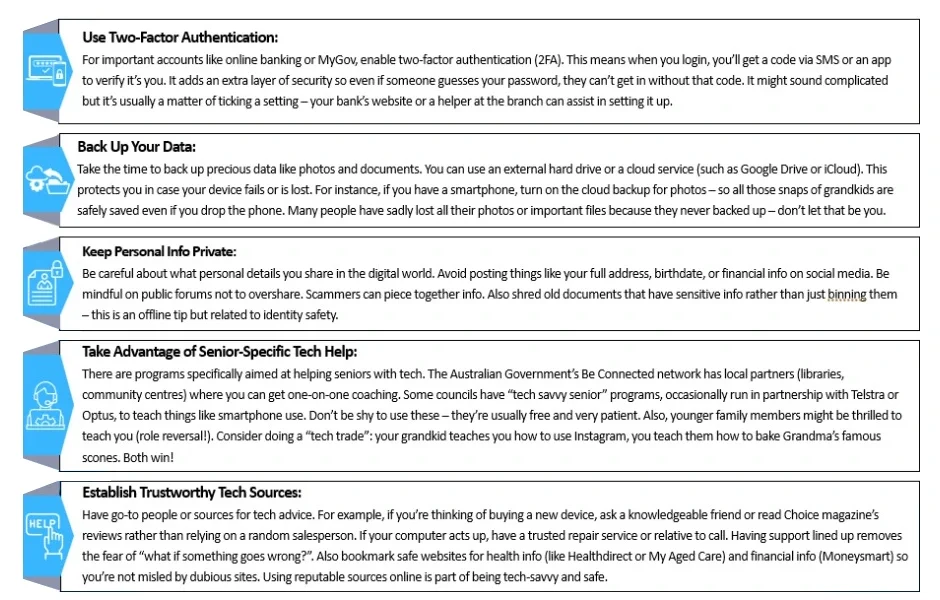
TECHNOLOGY & SAFETY
Technology really can open new doors in retirement – from exploring virtual museum tours around the world, to managing your health better, to simply finding entertainment on-demand. By taking it step by step and prioritising safety, you can reap the benefits without falling victim to the pitfalls. Remember, even if you’re late to the tech party, you can catch up – plenty of 70- and 80-year-olds are becoming whizzes at emailing, Facebooking, and more. Stay curious and cautious, and you’ll find the digital world has much to offer to make your retired life easier and more fun.
Administrative & legal Essentials
Retirement is the perfect time to get your affairs in order so that you and your family have peace of mind. Legal and administrative planning might not be fun, but it’s critically important. This includes making or updating your Will, setting up an Enduring Power of Attorney (EPOA) and Enduring Guardianship/Advance Care Directive (for medical and personal decisions), and organizing important documents. Think of it as a gift to your loved ones – clear instructions and legal documents will save them stress and uncertainty later. Unfortunately, a large portion of Australians have not sorted these basics: more than half of Australians die without a valid Will, according to legal experts. Even among those over 50, one-third don’t have a Will yet. So, if you’re in that boat, you’re certainly not alone – but it’s never too late to take action on this front.
Key legal documents every retiree should consider include:

By handling these matters, you lighten the load on your family and ensure your legacy is handled as you intend. Here are some action steps and tips to guide you:
Key Steps
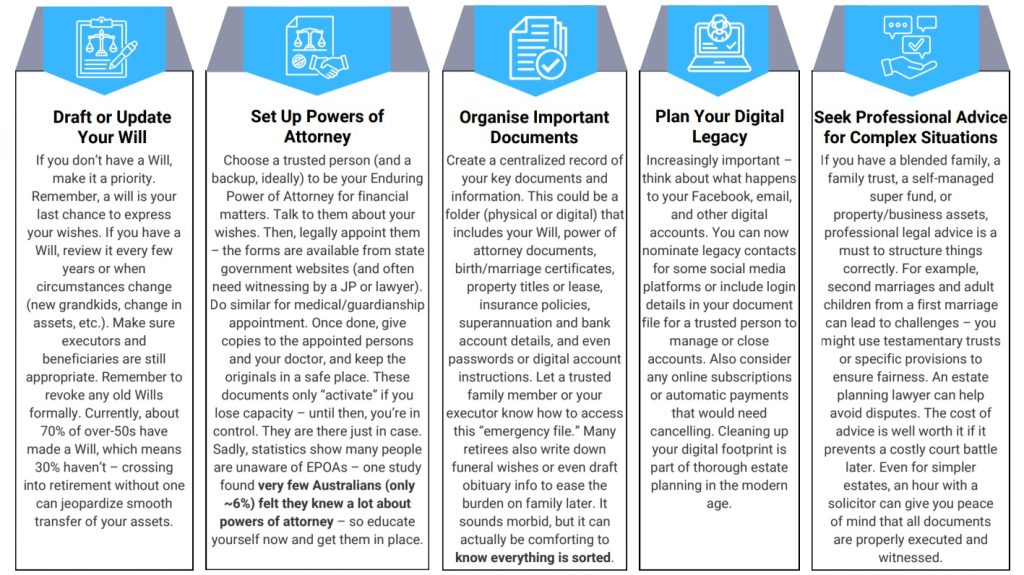
Top 5 Tips
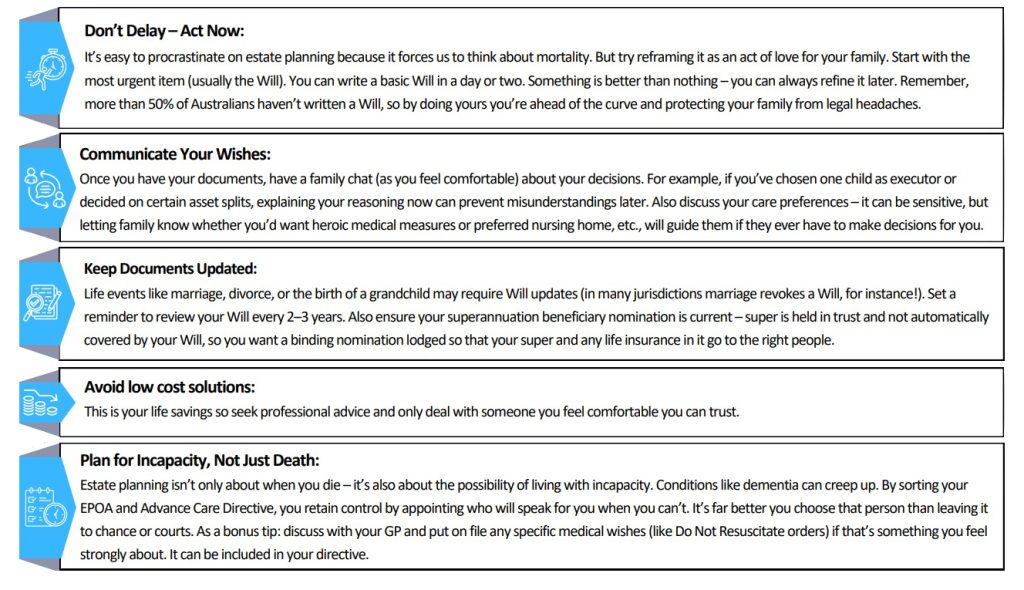
Once these legal pieces are in place, you can breathe a sigh of relief. It’s a one-time effort that yields long-term security. Keep your documents in a safe (fire-proof if possible) or with your solicitor and let your executors/attorneys know how to access them. Then get on with enjoying life, knowing that if fate throws a curveball, you’ve done your best to make things easier for yourself and your loved ones.












